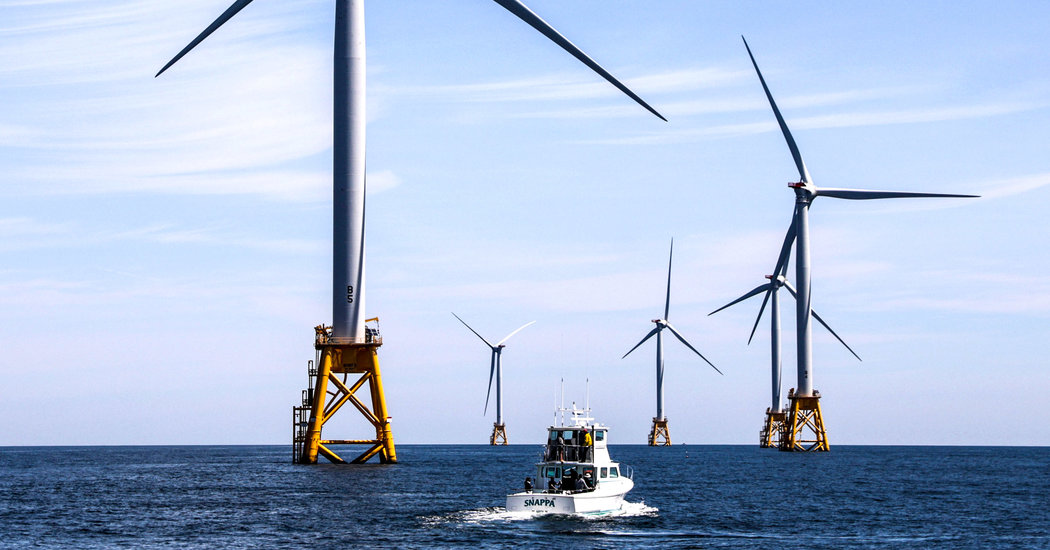
The Biden administration has promised to build up the offshore wind industry, and this week it began to make good on that pledge by granting final approval to the nation’s first large-scale offshore wind farm, about 15 miles off the coast of Martha’s Vineyard, Mass.
The project is significant not only for the amount of energy it’s expected to generate — 800 megawatts, or enough to power about 400,000 homes — but for the signal it sends about roughly a dozen other offshore wind projects along the Atlantic Coast.
The administration’s ultimate goal is to deploy enough offshore wind turbines by 2030 to power 10 million homes.
And, speaking of building … the administration’s approach to “building back better” is generating growing concern from some climate experts. They warn that the White House has yet to define a clear strategy for protecting Americans from the effects of climate change or fill key jobs to coordinate that work — a gap highlighted by the failure to reinstate a crucial rule on building in flood zones.
Quotable: “You can’t simply say, we’re going to have resilient infrastructure, without having a plan and definition for what that means,” said Alice Hill, who oversaw climate resilience during the Obama administration.
The (official) new normal, in interactive maps
“The world has warmed more than 1 degree Celsius since 1900 as a result of emissions of carbon dioxide and other heat-trapping gases.” My colleagues and I on the Climate desk at The Times have written that sentence, or something like it, more times than we can count.
But images can make the same point more viscerally. That was the case with a set of maps from the National Oceanic and Atmospheric Administration, which my colleague Jason Kao turned into a powerful animation.
The maps used “climate normals” — baseline averages of temperature, precipitation and other variables produced every 10 years for thousands of locations around the country. The 2020 set was released this month.
The normals, which use observations over the previous 30 years, are the basic weather data that we all make use of, perhaps without even realizing it. To take one small example, they’re how we know that yesterday’s high temperature was above or below normal, and by how much.
Join the conversation: Creating a ‘circular’ economy
The latest installment of our virtual event series, Netting Zero, is May 20. Andrew Ross Sorkin, a columnist and assistant business editor at The Times, will speak to activists and experts including Ellen MacArthur, the former champion yachtswoman who now runs a foundation focused on economic transformation, about reshaping the global economy in to fight climate change. You can sign up to attend here.
California’s new rule to cut smog
The freight trucks roll around the clock in Southern California, home to the largest concentration of mega-warehouses in the United States. They help feed our seemingly insatiable appetite for online shopping, but they’ve also helped make the area the worst in the nation for smog.
Last week, California passed a new rule that forces warehouses to clean up the emissions from the trucks that serve them, or take other measures to improve air quality.
The numbers: Last year, Inland Empire, a region close to the Los Angeles and Long Beach port where retailers and manufactures offload billions of dollars in goods, added 23 million square feet of new warehouse construction, an area the equivalent of nearly 500 football fields.
Why it matters: The heavy presence of industry in the area, combined with heat waves and wildfire smoke, helped make 2020 the smoggiest year in the region since the mid-1990s. Regulators say the rule will reduce harmful emissions from warehouse operations by up to 15 percent and result in up to 300 fewer deaths and up to 5,800 fewer asthma attacks.
Also important this week:
And finally, we recommend:
Cut from a Davos photo, now back in the picture
Vanessa Nakate, a climate activist, had just sat down for lunch in Davos, Switzerland, in January last year when she saw the photo that would catapult her to global fame — not for what it showed, but for what it did not
Just hours before, Nakate had participated in a news conference at the World Economic Forum in the Alpine town with four white activists. But when The Associated Press released a picture from the event, Nakate had been cropped out.
The omission shocked and saddened her. “I felt like I had wasted time going to Davos,” she said. “I felt that I shouldn’t have been at the news conference.”
Yet Nakate’s presence at the global gathering and the episode with the photo reverberated across the world. Now, she’s using her prominence to expand her work in Uganda and beyond.
If you’re not getting Climate Fwd: in your inbox, you can sign up here
We’d love your feedback on the newsletter. We read every message, and reply to many! Please email thoughts and suggestions to climateteam@nytimes.com.

Average Rating